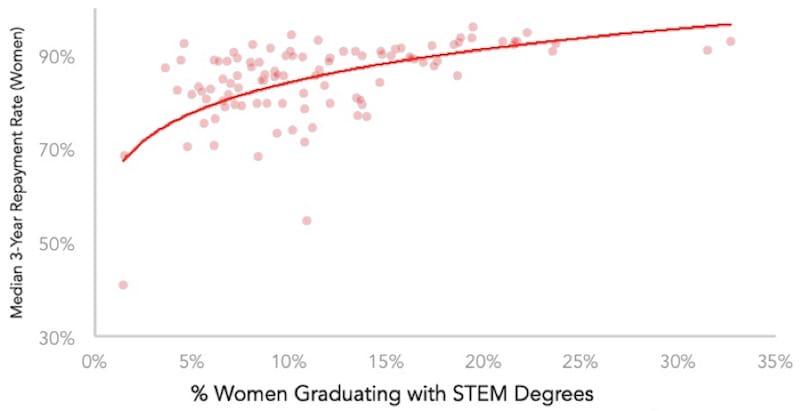Where do Women Study STEM?
Science, Technology, Engineering and Math (STEM) majors are among the most sought-after college graduates. They have an easier time finding a job, and they make more money.
Yet at every major college, a higher percentage of men than women major in STEM fields. It’s a major reason why men earn more money than women, and many colleges and universities have made graduating more women from STEM majors a priority.
Some colleges are doing better than others.
We investigated which schools have the most female STEM graduates and how much being a STEM major benefits those women financially. To do so, we analyzed data on the 100 American colleges and universities with the most undergraduates.
We found that certain schools, including four of the University of California campuses, graduate far more female STEM majors than the average school. On the other hand, at schools like NYU, barely 1 in 25 women graduate with a STEM major.
The data also shows that the U.S. News and World Report’s Top 25 schools vary greatly in their prominence of women in STEM.
Do STEM Graduates Earn More?
Before analyzing the proportion of female STEM majors by school, we wanted to confirm that STEM majors really do make more money than non-STEM majors.
We used 2016 Payscale data to look at median earnings (for both starting salary and mid-career salary) by primary college major. For this analysis, we considered a STEM major to be any degree in Computer Science, Engineering, Biology, Chemistry, Physics, Mathematics, Statistics, or Technology.
Data: Payscale
The results confirm that STEM majors earn higher salaries than their non-STEM counterparts. Straight out of college, STEM graduates earn about 35% more than their non-STEM peers. By mid-career, this gap grows to a difference of 47%.
How much more likely are men to graduate with STEM degrees? The following chart shows the percentage of STEM majors by gender at the top 100 schools from 2013 (the most recent year in the data).
We found that 6.7% of women graduate with STEM degrees compared to 17% of men. This means men are almost 2.5 times more likely to graduate with a STEM degree.
Where Women Study STEM
Which Schools Graduate the Highest Proportion of Female STEM Majors?
| RANK | SCHOOL | % FEMALE STEM MAJORS |
|---|---|---|
| 1 | University of California – San Diego | 32.70% |
| 2 | North Carolina State University at Raleigh | 31.50% |
| 3 | University of California – Davis | 23.70% |
| 4 | University of California – Berkeley | 23.50% |
| 5 | Virginia Polytechnic Institute | 22.20% |
| 6 | University of California – Los Angeles | 21.70% |
| 7 | University of Washington – Seattle | 21.60% |
| 8 | University of California – Irvine | 21.50% |
| 9 | University of Michigan – Ann Arbor | 20.90% |
| 10 | University of Wisconsin – Madison | 19.40% |
| 11 | University of Illinois at Urbana-Champaign | 18.80% |
| 12 | Texas A&M University – College Station | 18.70% |
| 13 | Kent State University at Kent | 6.10% |
| 14 | Pennsylvania State University | 18.60% |
| 15 | University of Maryland – College Park | 18.50% |
| 16 | SUNY Buffalo | 17.60% |
| 17 | Rutgers University – New Brunswick | 17.40% |
| 18 | The University of Texas at Austin | 17.30% |
| 19 | University of Florida | 16.80% |
| 20 | Michigan State University | 16.40% |
University of California, San Diego tops the list with one in three women graduating with a STEM degree. UC San Diego‘s proportion of STEM graduates is three times the national average.
Of the top five schools in the list, three are part of the University of California system. Perhaps the lure of Silicon Valley drives these high rates.
Which Schools Graduate the Lowest Proportion of Female STEM Majors?
We identified the schools at which women were particularly unlikely to choose a STEM major. The following table lists the 20 schools with the lowest proportion of female STEM graduates.
| RANK | SCHOOL | % FEMALE STEM MAJORS |
|---|---|---|
| 1 | Grand Canyon University | 1.50% |
| 2 | Liberty University | 1.50% |
| 3 | California State University – Fullerton | 3.60% |
| 4 | Texas State University | 4.20% |
| 5 | Utah State University | 4.40% |
| 6 | New York University | 4.60% |
| 7 | Ohio University | 4.80% |
| 8 | California State University – Northridge | 5.00% |
| 9 | California State University – Fresno | 5.30% |
| 10 | Central Michigan University | 5.50% |
| 11 | Middle Tennessee State University | 5.60% |
| 12 | California State University – Los Angeles | 5.70% |
| 13 | Kent State University at Kent | 6.10% |
| 14 | Pennsylvania State University | 18.60% |
| 15 | California State University – Long Beach | 6.10% |
| 16 | University of Nevada – Las Vegas | 6.20% |
| 17 | Grand Valley State University | 6.40% |
| 18 | California State University – Sacramento | 6.60% |
| 19 | University of North Texas | 6.60% |
| 20 | Indiana University – Indianapolis | 6.70% |
The difference between these schools and those in the top 20 is stark. Only about one in one hundred women at Liberty University or Grand Canyon University choose a STEM major. Both schools are primarily made up of online students.
At New York University, only slightly more than one in 25 undergraduate women choose to major in a STEM subject–one of the lowest rates in the country.
Which Top 25 Universities Graduate the Highest Proportion of Female Stem Majors?
We examined which of the most elite schools were most likely to have female STEM students. The following table shows the proportion of female STEM majors at the top 25 schools according to U.S. News & World Report.
| RANK | SCHOOL | % FEMALE STEM MAJORS |
|---|---|---|
| 1 | California Institute of Technology | 98% |
| 2 | Massachusetts Institute of Technology | 81.30% |
| 3 | Johns Hopkins University | 55.70% |
| 4 | Carnegie Mellon University | 43.30% |
| 5 | Columbia University | 36% |
| 6 | Duke University | 35.50% |
| 7 | Rice University | 33.60% |
| 8 | University of Pennsylvania | 31.30% |
| 9 | Princeton University | 30.90% |
| 10 | Cornell University | 30.70% |
| 11 | Stanford University | 29.10% |
| 12 | Emory University | 28.90% |
| 13 | Harvard University | 28.70% |
| 14 | University of California – Berkeley | 25.70% |
| 15 | Brown University | 25.60% |
| 16 | University of Notre Dame | 24.40% |
| 17 | University of California – Los Angeles | 22.80% |
| 18 | Dartmouth College | 21.80% |
| 19 | Yale University | 21% |
| 20 | University of Chicago | 20.40% |
| 21 | Georgetown University | 19.30% |
| 22 | Washington University in St. Louis | 19.10% |
| 23 | Vanderbilt University | 18.30% |
| 24 | University of Southern California | 18.20% |
| 25 | Northwestern University | 17.80% |
The top two schools are both engineering schools, although the California Institute of Technology (98%) still has a sizable lead over the Massachusetts Institute of Technology (81.3%). Among non-engineering universities, Johns Hopkins does best at 56%.
Which Top 25 Liberal Arts Colleges Graduate the Highest Proportion of Female Stem Majors?
We also looked at which of the top 25 liberal arts colleges had the the highest proportion of women in STEM. The results are in the below table:
| RANK | SCHOOL | % FEMALE STEM MAJORS |
|---|---|---|
| 1 | Harvey Mudd College | 91.40% |
| 2 | United State Naval Academy | 50.20% |
| 3 | Haverford College | 32.40% |
| 4 | Carleton College | 31.80% |
| 5 | Pomona College | 30.80% |
| 6 | Bryn Mawr College | 29.10% |
| 7 | United State Military Academy | 24.30% |
| 8 | Swarthmore College | 24% |
| 9 | Bowdoin College | 23.70% |
| 10 | Grinnell College | 22.60% |
| 11 | Hamilton College | 22.40% |
| 12 | Amherst College | 21.70% |
| 13 | Bates College | 21.70% |
| 14 | Wellesley College | 21.60% |
| 15 | Colorado College | 20.80% |
| 16 | Colby College | 20% |
| 17 | Williams College | 19.10% |
| 18 | Smith College | 18.80% |
| 19 | Oberlin College | 18.50% |
| 20 | Middlebury College | 18.10% |
| 21 | Colgate University | 17.80% |
| 22 | Wesleyan University | 16.30% |
| 23 | Macalester College | 15.40% |
| 24 | Vassar College | 15% |
| 25 | Washington and Lee University | 14.30% |
Harvey Mudd, a liberal arts school focusing on math, science and engineering, tops the list. More than nine in ten women who attend the school study a STEM subject. (Its unusual categorization as a liberal arts college is likely because it’s part of the Claremont Colleges.)
After Harvey Mudd and the Naval Academy, Haverford tops the list at 32%. The all-women colleges Wellesley and Smith don’t score particularly high or low by this measure.
Do Female STEM Majors Repay Their Loans Faster?
We know that the STEM field is majority male, and that STEM graduates make more money than their non-STEM classmates. This led us to wonder if women who graduated from schools with high rates of women in STEM actually had better financial outcomes.
The following chart plots the percentage of women in STEM degrees against the 3-year student loan repayment rate for female graduate of that school. The trendline shows that overall, schools with higher concentrations of women in STEM have female graduates who repay their loans faster.

The data points toward the right of the graph are the University of California schools we saw above. They demonstrate that schools with 20% or more of their female students in STEM graduate women who repay their loans within 3 years nearly 90% of the time.
On the other hand, women who graduate from schools on the left side of the graph, which are schools with fewer than one in 20 women in STEM, have lower repayment rates.
Since women with STEM degrees make more money, it makes sense that they have higher repayment rates.
Choosing a STEM-Focused College

So which college should women interested in STEM attend, and which colleges are graduating women from STEM majors?
To the extent that data can help answer that question, this analysis suggests that there is a lot of variation. Engineering schools obviously graduate many women in STEM, but so do a number of UC colleges, while some large online universities have particularly few women in STEM.
Although the wage gap has slowly fallen, women still make about 78% of what their male peers earn. Since STEM graduates earn hundreds of thousands of dollars more, on average, over their careers, the lack of women in STEM is a major reason why.
Even as Americans consider electing a woman to the presidency, computer science lectures, freshman orientations, and college administrator meetings will remain quiet battlegrounds for gender equality.